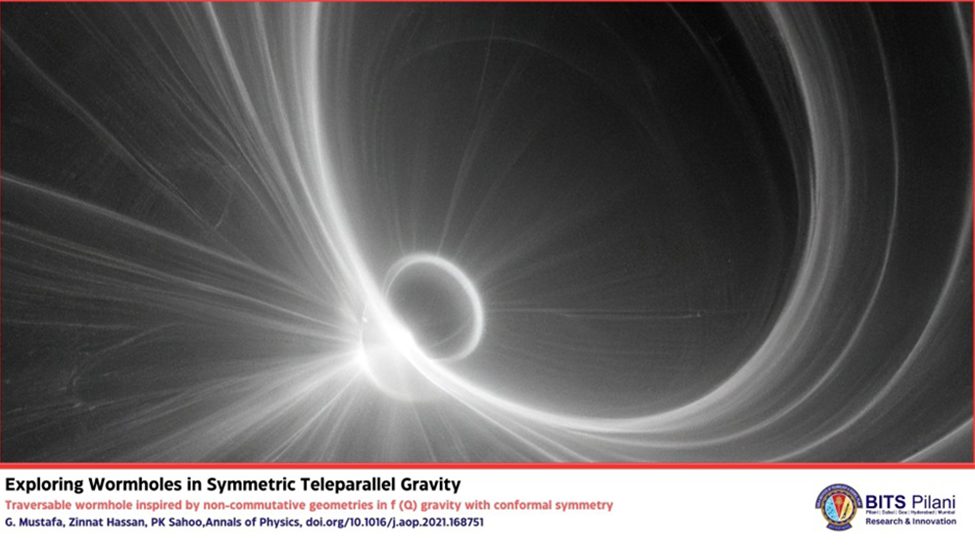Wormholes, a captivating theoretical concept, offer a potential shortcut through space and time—a celestial tunnel connecting distant points through the intricate fabric of space-time. The inception of this idea dates all the way back to 1935 when Albert Einstein and Nathan Rosen proposed the concept of a wormhole, also known as an Einstein-Rosen bridge, as a unique solution within the framework of Einstein's General Relativity(GR). The hypothetical existence of wormholes carries profound implications for space travel, such as the ability to traverse vast cosmic distances in remarkably short durations, and exploring their properties and implications could provide important information about the structure of space-time itself.
Furthermore, being closely linked to other perplexing cosmic phenomena, such as black holes, dark matter, and the enigmatic event known as the Big Bang—the cosmic genesis that set our universe into motion—wormholes have the potential to provide insights into these cosmic puzzles and deepen our understanding of the origin of the universe. Additionally, investigating wormholes could help bridge the gap between GR and quantum mechanics, which is currently one of the most important problems in theoretical physics.
Inspired by this, a team of researchers, led by Dr. P.K. Sahoo in collaboration with Mr. Zinnat Hassan from the Department of Mathematics at the Hyderabad Campus of Birla Institute of Technology (BITS) Pilani, recently delved into the investigation of wormholes. They focused on the modified teleparallel gravity framework with conformal symmetry within the context of non-commutative geometry. The primary objective of their research was to shed light on the specific conditions required for the existence of wormholes within the above framework. “The study of wormholes within the context of f(Q) symmetric teleparallel gravity with conformal symmetry under non-commutative geometry represents a sophisticated and specialized area of research in the field of theoretical physics and cosmology,” says Dr. Sahoo. Their findings were published in volume 437 of the journal Annals of Physics in February 2022.
Teleparallel gravity, a modification of GR, offers a unique perspective on gravity, which, in this framework, arises from the torsion of a non-metric and flat space-time, unlike the curvature-based gravity in GR. With the potential to explain cosmic mysteries like dark matter and dark energy, teleparallel gravity is touted to be a fitting framework for studying wormholes.
In their study, the team also used conformal symmetry, which not only simplifies the mathematical complexity of the problem but also provides deeper insights into the geometrical and physical properties of wormholes within this gravitational framework. Additionally, by employing non-commutative geometries, the team could understand the structure of the fabric of space-time at extremely small scales and, in turn, determine the quantum effects near the wormhole.
By constructing shape functions under two different non-commutative geometries called Gaussian and Lorentzian distributions, the researchers explored the behavior of wormholes both analytically and graphically. They found that, under both distributions, the shape functions are increasing in nature and cannot achieve asymptotic flatness. Additionally, the energy density also exhibits a consistent positive decrease throughout the wormhole’s space-time.
Furthermore, their investigation encompassed energy conditions, particularly the null energy condition (NEC), which was found to be violated at the wormhole throat. This indicated the presence of exotic matter at the throat, which is a necessary ingredient for a traversable wormhole. To further verify the presence of exotic matter, the researchers analyzed the “exoticity parameter,” which was found to be positive at or near the throat, implying that the throat is filled with exotic matter.
Using the Tolman–Oppenheimer–Volkoff equation, they then assessed the stability of their solutions and found the wormhole to be stable. These results suggested that all the necessary conditions required for the existence of a traversable wormhole are satisfied under the non-commutative geometries and conformal symmetry.
Highlighting the importance of the present study, Dr. Sahoo remarks: “This research could contribute to our understanding of the possibilities and limitations of traversable wormholes, which could significantly impact future space exploration endeavors and lead to a more comprehensive theory of quantum gravity. Moreover, this research could be used by scientists to develop advanced teleportation technologies, which, in turn, could help skyrocket space exploration, enabling us to reach distant galaxies within the span of a human lifetime.”
While the direct impact of this research on everyday life might be more long-term and indirect, it underscores the importance of expanding the horizons of our scientific knowledge. The insights gained could pave the way not only for technological innovations but new theoretical frameworks and a deeper comprehension of our vast cosmos.
















